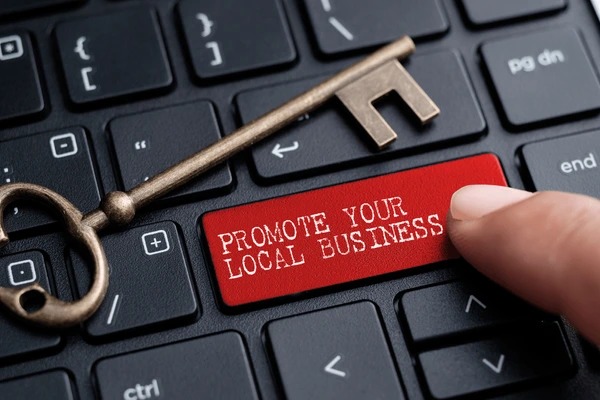People still enjoy helping local companies even when online buying is only getting more popular. Many would rather spend money where they live, whether for a coffee from a neighborhood café or a local plumber hired. The question “how to promote your business locally” in the mind of an enterpreneure is, therefore, still important. It also distinguishes small enterprises and keeps them strong in their local areas.
Your company is building trust when it appears in neighborhood social feeds, in local search results, or is referenced at a local event. And returning folks are drawn back by trust.
“People do business with people they know, like, and trust.”
Therefore, this blog is loaded with tried-and-true techniques for local reach, regardless of your level of ambition as a new business owner. Online tools and offline solutions abound, all meant to help your company be seen where it most counts—right in your backyard. So, let us focus on the first step:
Establish a Strong Online Presence
In today’s world, people look online before they visit a store, try a new restaurant, or call a service provider. That means your first impression often happens on a screen—not in person. They’ll probably find your competition if they can’t find you online.
Start with a Google Business Profile
When someone searches for “bakery near me” or “best mechanic in [your city],” Google shows local listings first. So, these listings are pulled from Google Business Profiles. If you haven’t claimed yours yet, now’s the time.
Here’s what to do:
- Claim your profile at google.com/business.
- Add your business name, address, phone number, and hours.
- Upload real photos of your space, products, and staff.
- Choose the right business categories.
- Write a short description with local keywords.
- Post updates about promotions, events, or changes.
Fact: “Businesses with photos receive 42% more requests for directions on Google Maps.”
Regular updates tell Google your listing is active, boosting its visibility in search results and Google Maps.
Optimize Your Website for Local Searches
Your website doesn’t need to be complex. But it does need to be clear, fast, and mobile-friendly. Most people search from their phones, so your site should load quickly and be easy to read.
Here are the basics:
- Use your city name in page titles and headers.
- Write blog posts or pages for each service and location you serve.
- Include your address and phone number on every page.
- Add customer testimonials, especially from local clients.
- Embed a Google Map on your contact page.
If you want to take it further, tools like Semrush help you track how well your site ranks in local search and suggest ways to improve.
Get Listed in Local Directories
Beyond Google, there are many places where your business can appear:
- Yelp
- Bing Places
- TripAdvisor (great for restaurants or tourism)
- Apple Maps
- Facebook Business Pages
Consistency is key. Ensure your name, address, and phone number (NAP) are the same across all platforms.
“Local businesses appear in 93% of Google’s top search results when listings are consistent.”
Add Local SEO to Your Content
Local SEO means using words and phrases that match what people in your area are searching for. For example, instead of “plumbing services,” say “affordable plumber in Tulsa.”
Here’s how to use local keywords:
- In page titles and meta descriptions
- In blog posts or service pages
- Image alt text
- In your URL if possible (e.g., yoursite.com/los-angeles-cleaning)
Leverage Social Media Platforms
You don’t need to be everywhere on social media—but you do need to be somewhere. People spend hours daily on platforms like Facebook, Instagram, and TikTok. That’s where conversations happen, events get shared, and opinions spread. You miss a big chance to connect if your business isn’t part of that space.
Moreover, social media gives local businesses a free and powerful way to build relationships. You can reach new customers, talk to current ones, and stay fresh in people’s minds. Even better, it’s personal. Finally, it lets people see the real faces, stories, and values behind your brand.
Start Conversations, Not Just Promotions
One mistake businesses make is using social media only to push sales. But people don’t scroll to be sold to—they scroll to connect. Mix in posts that feel human instead of just posting deals or hours.
Try sharing:
- Behind-the-scenes photos of your team or workspace
- Stories about why you started the business
- Local events you’re attending or supporting
- Polls or fun questions to get feedback
- Seasonal tips or quick how-to videos
Focus on Platforms Your Community Uses
You don’t need to be on every app for “how to promote your business locally”. Instead, pick one or two platforms your local audience uses. If you run a food truck, Instagram might be your best bet. If you’re a local accountant, Facebook or LinkedIn might work better.
Here’s a quick guide:
- Facebook: Great for community groups, events, and local storytelling.
- Instagram: Perfect for visual content, product photos, or short videos.
- TikTok: Useful for younger audiences and creative behind-the-scenes content.
- Nextdoor: A hyper-local app designed for neighborhoods and community updates.
So, whatever you choose, post consistently. You don’t need to post daily, but a few times a week keeps your business active and visible.
Use Local Hashtags
Hashtags help people find your content, especially when they search by city or neighborhood. Adding the right ones makes your posts more discoverable by people nearby.
Some examples include:
- #ShopSmallChicago
- #HoustonEats
- #DenverMoms
- #[YourNeighborhood]Business
Also, search for hashtags used by local influencers, event pages, or community groups. Mirror some of those hashtags to join local conversations.
Fact: “Posts with hashtags get over 12% more engagement than those without.“
Could you keep it simple, though? Use 3 to 5 solid local hashtags per post—not 20 random ones.
Team Up with Local Influencers
You don’t need a celebrity to make an impact. Micro-influencers with 1,000 to 10,000 local followers are often more trusted and relatable. Their audience likely lives near you, which makes them the perfect partner.
Moreover, reach out to a few local creators. Offer them a free product or service in exchange for a mention. They might also post a story, create a short video, or tag your page in a caption. That single post could introduce you to hundreds of nearby customers.
Better yet, keep the relationship going. Invite them to your next event or let them try new products first. When influencers genuinely like your business, they’ll talk about it repeatedly.
Join and Contribute to Community Groups
Facebook groups, Reddit threads, or local Discord servers are full of conversations between neighbors. Don’t jump in just to promote. Instead, offer help, answer questions, or share useful info.
For example, if someone asks, “Does anyone know a good dog groomer?” and that’s what you do, respond with a friendly answer—maybe even a link to your booking page. That kind of low-pressure interaction builds real trust.
“It’s not about being the loudest. It’s about being the most helpful.”
Participate in Community Activities
While online tools help people find your business, face-to-face moments help them remember it. That’s where real connection happens. Getting involved in community activities isn’t just good PR—it builds long-term trust. It shows people that you care about more than just selling—you care about the neighborhood.
Support or Sponsor Local Events
Events unite people, and sponsoring can put your business front and center. There’s always something happening, from school carnivals to town festivals to charity 5Ks.
However, you don’t need a big budget to help. Sometimes it’s just donating snacks, printing flyers, or setting up a booth.
Here’s what local sponsorship can do:
- Get your logo printed on shirts, banners, or programs.
- Give you a chance to speak or hand out materials.
- Create brand recognition with families and other business owners.
The real value? People start to associate your business with community pride. That’s the feeling money can’t buy.
Host a Free Workshop or Class
Think about what you know. Can you teach others something useful? Hosting a free event—even small—builds credibility and brings people to your door.
A few examples:
- A bakery teaches cookie decorating to kids.
- A bike shop offers a “how to fix a flat” demo.
- A local gym holds a free outdoor workout.
Join Local Business Organizations
Joining your Chamber of Commerce or neighborhood business group is a smart move. So, these organizations connect you with other local owners, city leaders, and even press outlets. Lastly, they often host mixers, seminars, and co-marketing opportunities.
Benefits include:
- Listing your business in local directories
- Getting invited to private networking events
- Learning about grant programs or city incentives
- Gaining visibility in newsletters and email blasts
Not only can these groups help you grow, but they also make your business part of something bigger—your local economy.
Partner with Other Small Businesses
Sometimes, two businesses are better than one. Look for local shops or service providers that complement yours. So, a coffee shop could team up with a bookstore. So, a gym could work with a smoothie bar. A real estate agent might also partner with a cleaning company.
Together, you can:
- Cross-promote each other on social media
- Offer package deals or referral swaps
- Split booth costs at events
However, these partnerships expand your reach without adding more work. Plus, they also help you build strong connections in your business community.
Fact: “Businesses that collaborate locally see up to 20% more customer retention.“
Volunteer or Donate Time
You don’t need a marketing budget for “how to promote your business locally”. Volunteering at a shelter, food drive, or school event shows that your business stands for something.
Wear a branded shirt, bring business cards, and don’t be afraid to discuss your work. But focus on the cause first. People remember generosity—and they tell others about it.
Participate in Community Activities
While online tools help people find your business, face-to-face moments help them remember it. That’s where real connection happens. Getting involved in community activities isn’t just good PR—it builds long-term trust. It shows people that you care about more than just selling. So, you care about the neighborhood.
Being visible at local events, working with other businesses, or simply showing up can make a lasting impact. Even small efforts go a long way when they feel genuine.
“When you support a small business, you support a dream.”
Let’s explore a few simple ways to show up and make an impression.
Support or Sponsor Local Events
Events bring people together; sponsoring can also put your business front and center. There’s always something happening, from school carnivals to town festivals to charity 5Ks.
So, you don’t need a big budget to help. Sometimes, it’s just donating snacks, printing flyers, or setting up a booth.
Here’s what local sponsorship can do:
- Get your logo printed on shirts, banners, or programs.
- Give you a chance to speak or hand out materials.
- Create brand recognition with families and other business owners.
The real value? People start to associate your business with community pride. That’s the kind of feeling money can’t buy.
Host a Free Workshop or Class
Think about what you know. Can you teach others something useful? Hosting a free event—even small—builds credibility and brings people to your door.
A few examples:
- A bakery teaches cookie decorating to kids.
- A bike shop offers a “how to fix a flat” demo.
- A local gym holds a free outdoor workout.
Furthermore, events like these turn curious guests into future customers. They also make great content for social media. Be sure to share photos, tag attendees, and encourage them to post about the event.
“People will forget what you said, but they’ll never forget how you made them feel.”
Join Local Business Organizations
Joining your Chamber of Commerce or neighborhood business group is a smart move. So, these organizations connect you with other local owners, city leaders, and even press outlets. Plus, they often host mixers, seminars, and co-marketing opportunities.
Benefits include:
- Listing your business in local directories
- Getting invited to private networking events
- Learning about grant programs or city incentives
- Gaining visibility in newsletters and email blasts
Not only can these groups help you grow, but they also make your business part of something bigger—your local economy.
Partner with Other Small Businesses
Sometimes, two businesses are better than one. Look for local shops or service providers that also complement yours. So, a coffee shop could team up with a bookstore. A gym could work with a smoothie bar. A real estate agent might also partner with a cleaning company.
Together, you can:
- Cross-promote each other on social media
- Offer package deals or referral swaps
- Split booth costs at events
So, these partnerships expand your reach without adding more work. Plus, they also help you build strong connections in your business community.
Fact: “Businesses that collaborate locally see up to 20% more customer retention.”
Volunteer or Donate Time
You don’t need a marketing budget to make a difference. Thereofer, volunteering at a shelter, food drive, or school event shows that your business stands for something.
Wear a branded shirt, bring business cards, and don’t be afraid to chat about what you do. But focus on the cause first. Finally, people remember generosity—and they tell others about it.
Utilize Traditional Marketing Methods
With all the talk about online strategies, it’s easy to forget about the old-school methods. But here’s the truth: traditional marketing still works, especially when promoting your business locally. People still walk by bulletin boards, check their mail, and listen to the radio during their morning commute. So don’t leave these tools behind—they can give your business a real edge in your community.
“Marketing is no longer about the stuff you make but about the stories you tell.”
Let’s look at how you can use offline strategies to get real results.
Flyers, Posters, and Local Boards Still Matter
If your business is local, make sure you’re showing up in local places. Libraries, coffee shops, gyms, grocery stores, and laundromats usually have community boards. Therefore, these spots are perfect for posting a colorful flyer or event notice.
Make your flyers count:
- Use big, clear fonts with just one main message.
- Include your logo, website, and phone number.
- Add a strong call to action like “Stop by today!” or “Bring this flyer for 10% off.”
Bonus tip: Add a QR code so people can scan and visit your website right from their phone. That’s a simple way to bridge offline and online marketing.
Fact: “Print materials offer higher brand recall compared to digital ads.”
While not everyone will stop and read every flyer, a well-placed one can lead to steady foot traffic—especially when it’s near your business.
Reach Out to Local Press and Radio
Many small businesses skip this step, thinking local media won’t care. But they love stories about community, new businesses, or people making a difference. So, that’s where you come in.
Send a short, friendly email to your town’s newspaper editor or local radio host. Tell them who you are, what your business does, and why it matters to the community.
You could pitch stories like:
- “How a local mom started her bakery after losing her job.”
- “Downtown shop donates winter coats with every purchase.”
- “New store brings eco-friendly products to Main Street.”
So, these features build credibility and get your name in front of readers who live right down the block. Yet, don’t forget to share the article on your social media and website.
Try a Direct Mail Campaign
Email inboxes are full. But real mailboxes? Not so much. A simple, well-designed postcard can catch someone’s attention better than a crowded Gmail promo tab.
Here’s how to make it work:
- Keep your design bold, bright, and simple.
- Highlight a clear offer, like “Free coffee with any pastry this month.”
- Use first names if possible, or mention the town name.
- Add a deadline to create urgency.
So, this works well for special deals, event invitations, or new business announcements. And because it feels more personal, people are more likely to pay attention.
“Direct mail offers a 29% return on investment, especially for local outreach.”
Use Vehicle and Window Signage
If your business has a storefront or service vehicle, use them! A simple window sign with your hours, services, or deals helps inform passersby. Adding your business name and contact info to your car turns every trip into a moving billboard.
Consider how many people see your vehicle during school drop-offs, grocery runs, or rush-hour traffic. A clean design and bold contact info go a long way.
Include Printed Handouts Inside Every Purchase
Let’s say you run a retail shop or food truck. Drop a small card or flyer into each bag. It could include:
- A thank-you message
- A link to your social media
- A referral discount for friends
- A promo code for next time
Finally, people remember thoughtful details, which turns every customer into a possible promoter.
Encourage Customer Reviews and Referrals
Word of mouth is powerful. It might be the most trusted form of marketing out there if you want to know “how to promote your business locally”. People want to hear from other real people—especially when choosing a local business. Those little nudges can lead someone straight to your front door, whether it’s online reviews or a friend’s recommendation.
“A customer talking about their experience with you is worth ten times what you write or say about yourself.”
So, how do you get more people to spread the word?
Ask for Reviews (And Make It Easy)
Happy customers are often glad to leave a review—but only if you ask. Sometimes, all it takes is also a friendly reminder.
Here’s how to do it:
- Include a short review request in your email receipts.
- Put a small sign at the checkout counter with a QR code linking to your Google or Yelp page.
- Ask face-to-face, especially after a customer compliments your service.
People are more likely to act immediately, so don’t wait too long to ask.
And don’t stress about getting 5 stars every time. A mix of honest reviews builds more trust than a perfect score. What matters most is that you respond to reviews, thank people, and address care concerns.
Start a Simple Referral Program
Sometimes, people need a little nudge to recommend you. That’s where referral programs come in. Give your current customers a small incentive to send new people your way. So, it doesn’t have to be anything fancy—just a nice thank-you.
Easy ideas include:
- $5 off for both the referrer and the new customer
- A free product or service after three referrals
- A “Refer a Friend” card with space to write names
Fact: “92% of consumers trust referrals from people they know.”
Make it easy to track and even easier to share. Customers who feel appreciated are much more likely to talk about your business.
And remember: people want to support local businesses. Finally, they must be reminded that sharing your name helps you grow.
Offer Local Promotions and Loyalty Programs
Everyone loves a deal—especially when it feels like it was made just for them. Local promotions and loyalty programs don’t just drive sales. They build relationships. So, they tell your regulars, “Hey, we see you. And we’re glad you came back.”
Finally, these small gestures can lead to long-term customer habits. And best of all? They don’t need to cost you much at all.
Run Local-Only Specials
Create deals specifically for people in your neighborhood. For example, you could offer a Tuesday discount for nearby office workers or a weekend special for locals who mention your social media post.
Ideas for local promos:
- “Neighborhood Night” with 15% off after 6 PM
- “Locals Only” coffee cards redeemable with an ID
- Partner discounts with nearby stores (“Show your receipt from [Store A] to get 10% off here”)
These offers also encourage word-of-mouth and help you build loyalty with people nearby.
Therefore, promote these specials using signs, social posts, and direct mail. So, remember to use language that makes locals feel like insiders: “Just for our neighbors” or “You’re part of our circle.”
Set Up a Loyalty Program
Loyalty programs are simple, low-cost ways to reward return visits. And they work.
“Repeat customers spend 67% more than new ones.”
Here are a few easy formats:
- Punch cards: “Buy 5, get 1 free” works great for coffee shops or bakeries.
- Points system: Each dollar spent earns points toward a reward.
- Digital loyalty apps: Services like Square and Toast offer easy loyalty features.
Make sure rewards come quickly. If customers spend $500 before earning anything, they’ll lose interest. But if the reward feels within reach, they’ll return more often.
Also, use your loyalty system to collect names and birthdays. Finally, a surprise birthday coupon or thank-you note can greatly make customers feel valued.
Consistency Builds Community
Growing your business locally isn’t about doing everything at once. It’s also about showing up—again and again—where your customers already are. From boosting your online presence to handing out a flyer at a community event, each step builds trust. And trust leads to loyalty.
Even small actions, when done consistently, can spark big results. So, instead of chasing trends or waiting for the perfect moment, start with what feels doable for “how to promote your business locally”. Whether posting weekly on social media or running a referral program, every move adds up.
Remember, people also want to support businesses that feel familiar, honest, and involved. When they see your name around town—online and offline—they’ll remember you. And more importantly, they’ll choose you. That’s the heart of local promotion—and the key to building a business your community will stand behind.

















Leave a comment